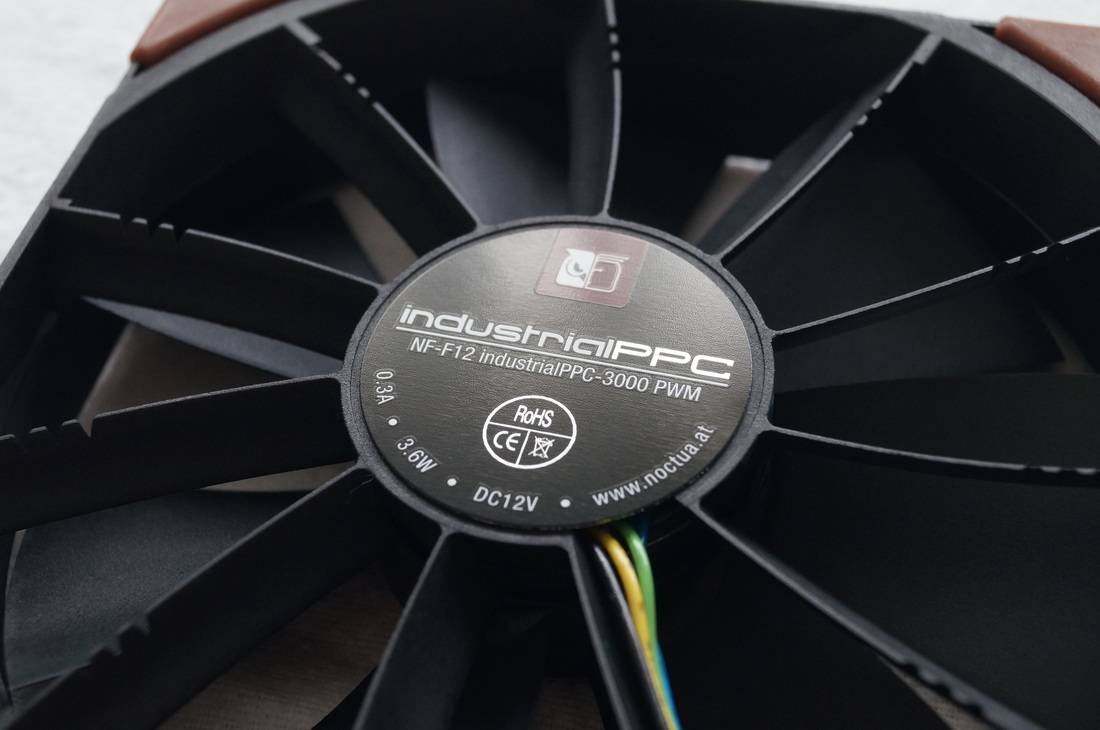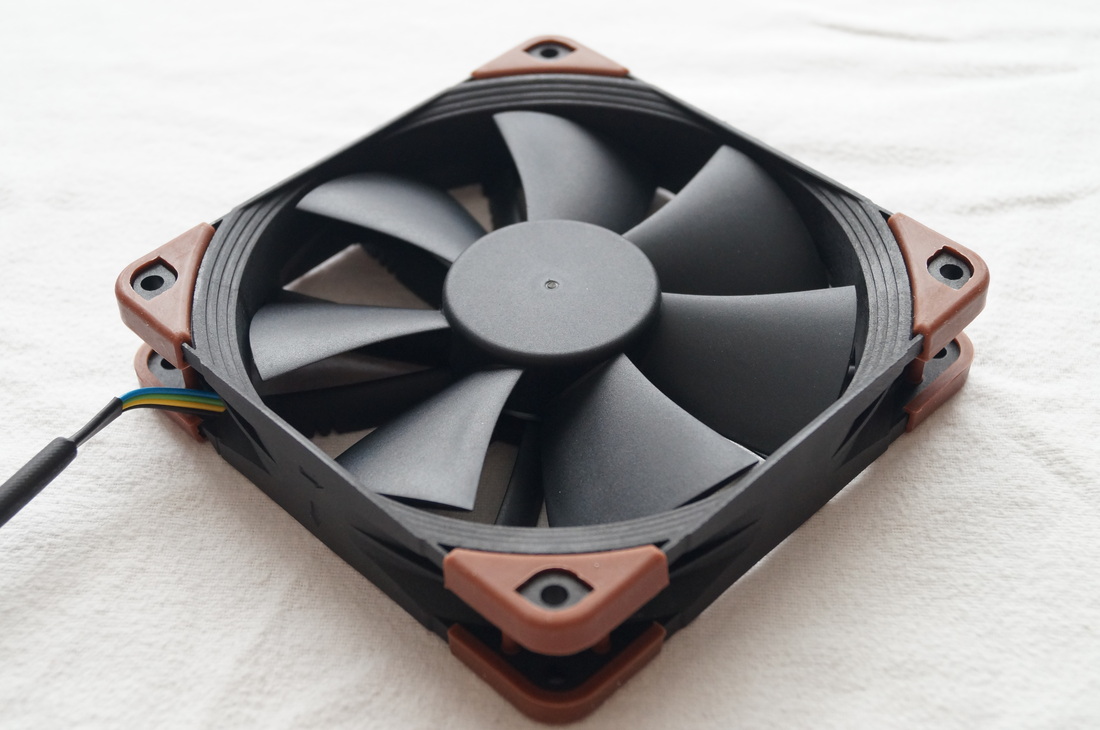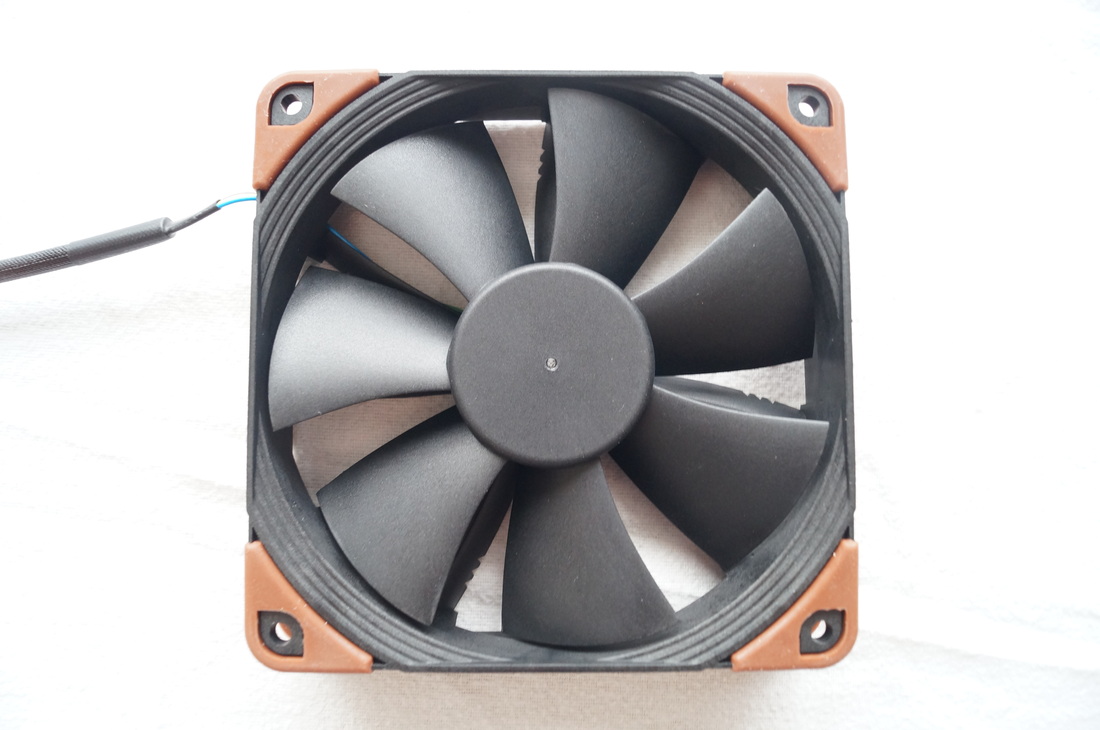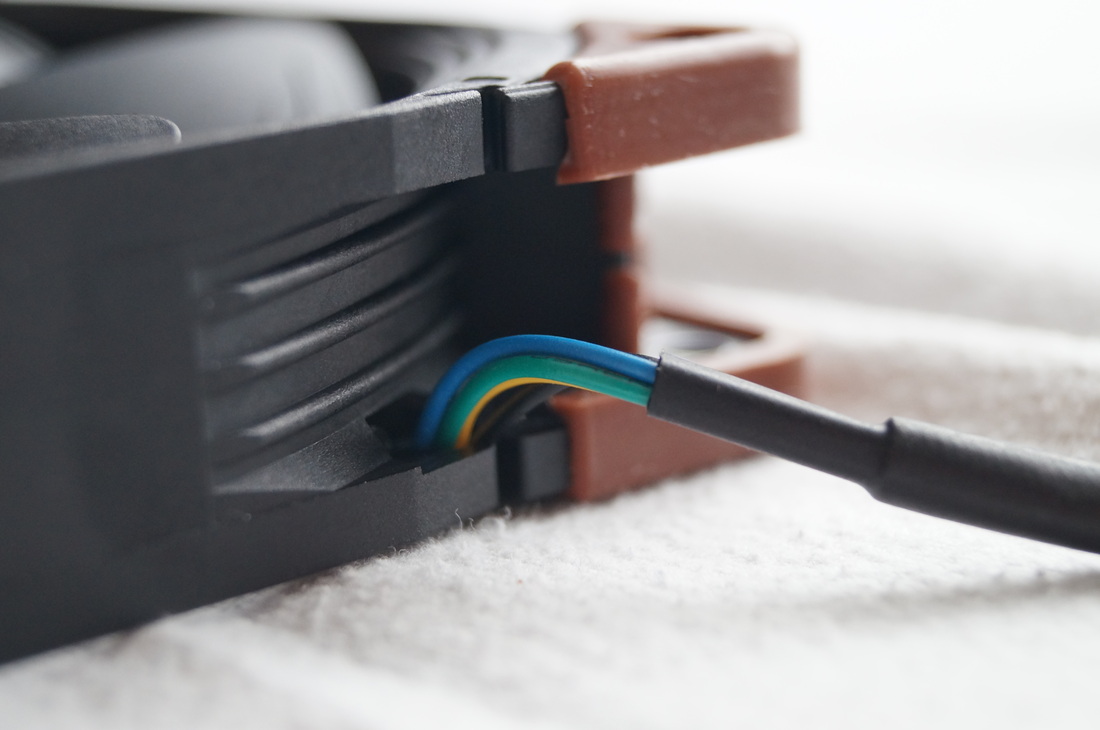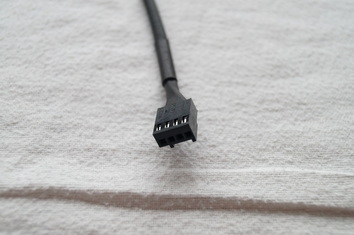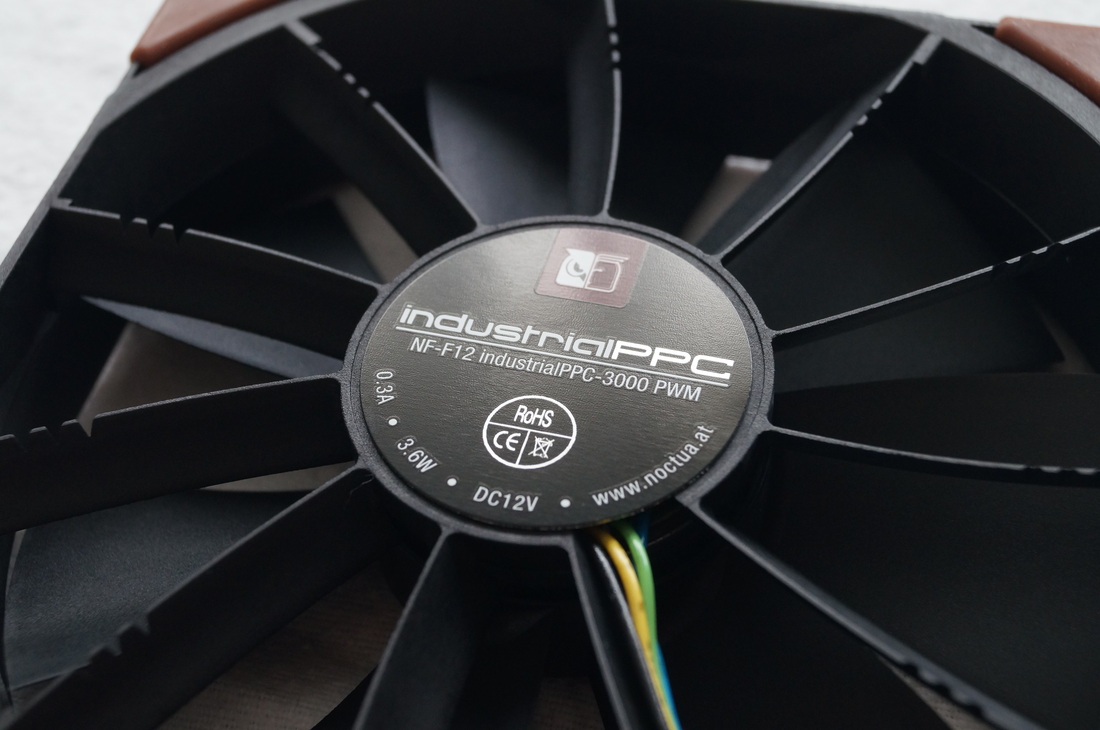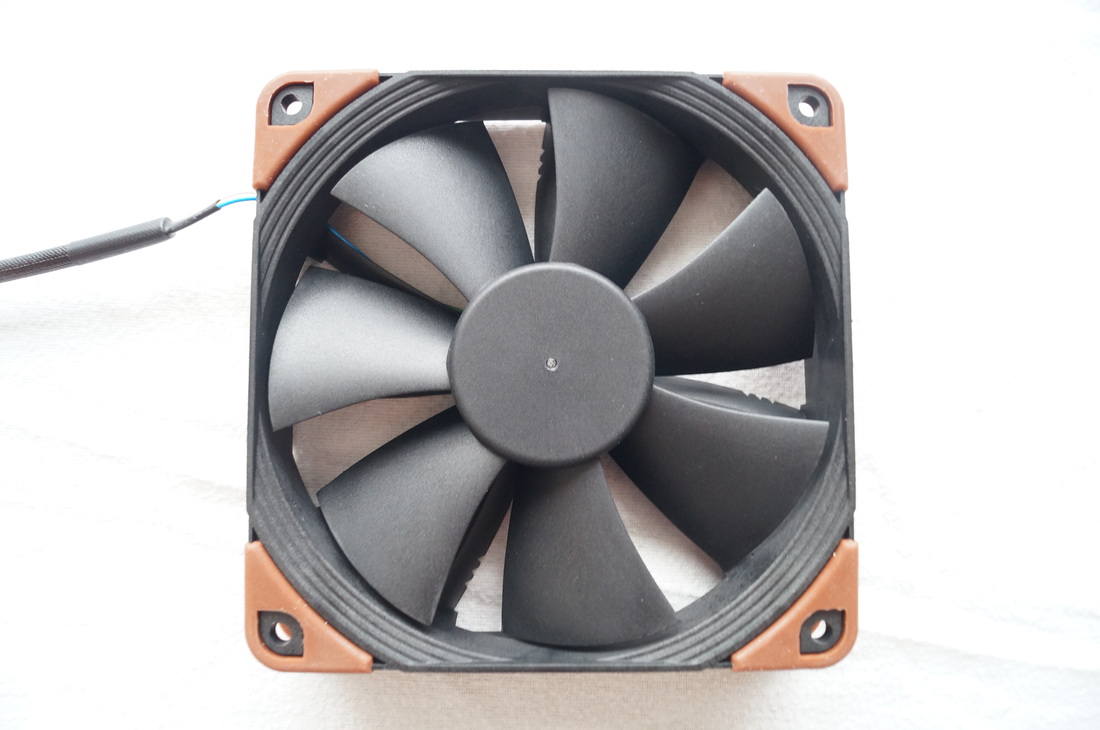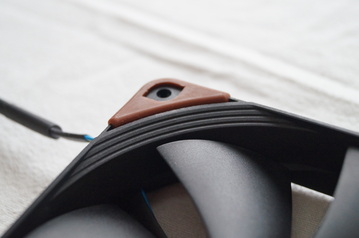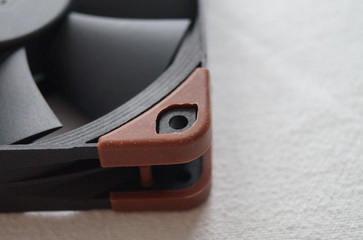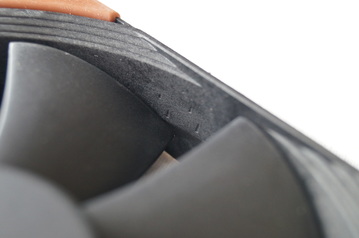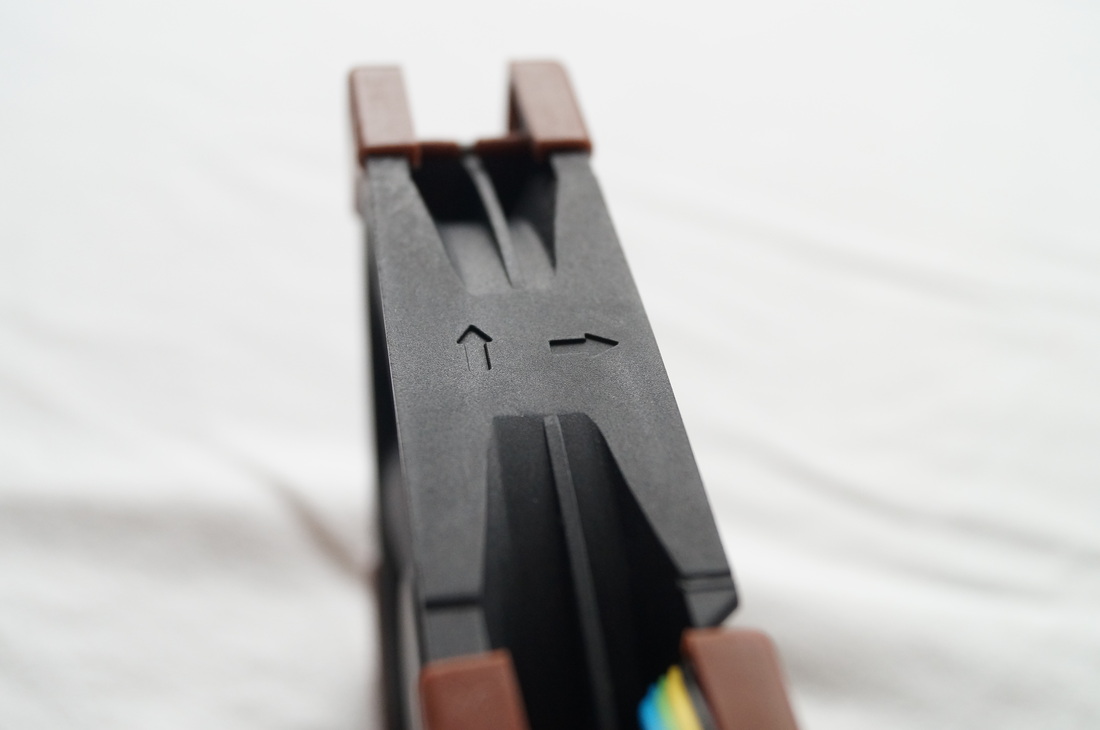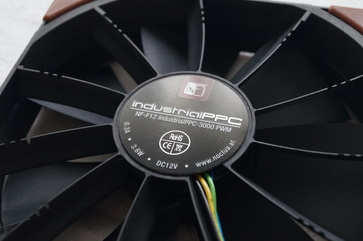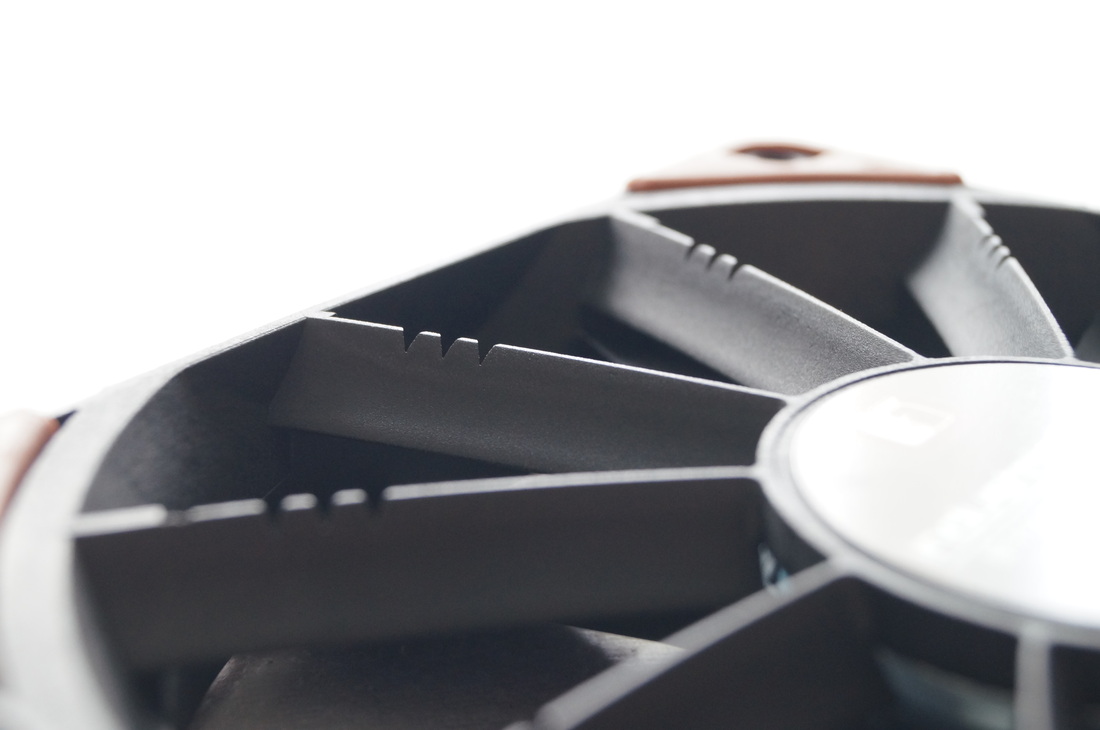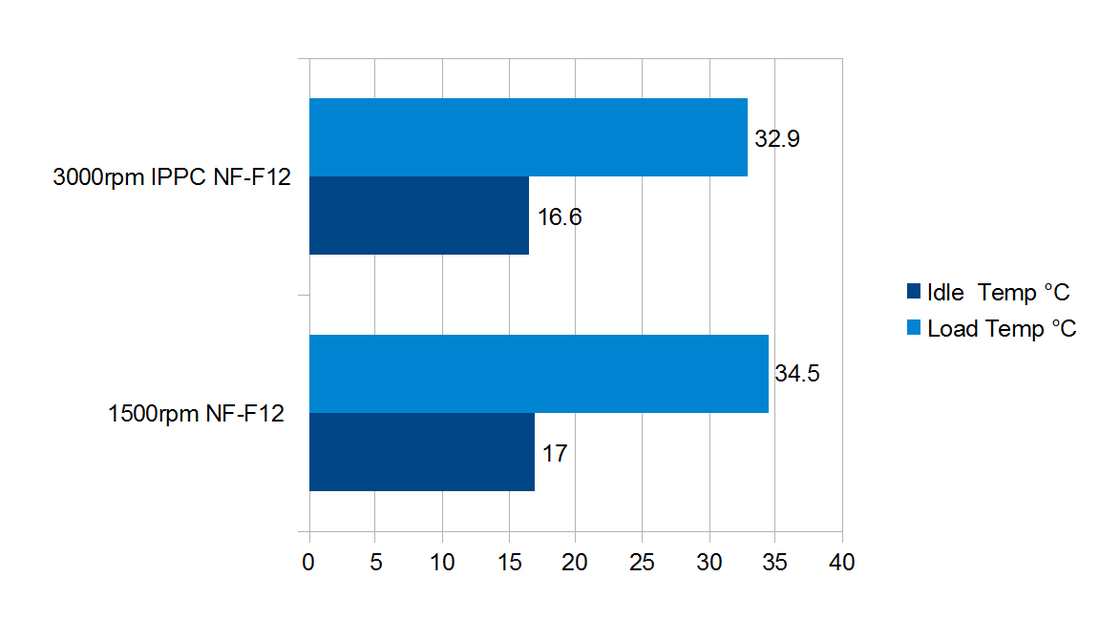Here's the spec:
| Model: Dimensions Connector Motor Certification Min RPM Max RPM Max Airflow Max Noise Noctua link for full spec: | 2000 120x120x25 3 pin 3-phase IP52 N/A 2000 121.8 m³/h 29.7 dB(A) | 2000 PWM 120x120x25 4 pin PWM 3-phase IP52 450 2000 121.8 m³/h 29.7 dB(A) | 2000 IP67 120x120x25 4 pin PWM 3-phase IP67 450 2000 121.8 m³/h 29.7 dB(A) | 3000 PWM 120x120x25 4 pin PWM 3-phase IP52 750 3000 186.7 m³/h 43.5 dB(A) |
Design:
We have previously reviewed Noctua's NF-F12 but this was back during the early days of HalTech so we will cover all of the NF-F12 design including the changes made to the IPPC versions. As many people will already be familiar with the NF-F12 design, lets go over all the changes Noctua have made to the original design to make it better.
| Starting with the most obvious change, Noctua have opted for a sleeker more popular colour scheme of, well, black. This is tied in a way I would believe to the fact they are more premium fans as well as the fact they have changed the material used to make the products, moving from a fibreglass reinforced PBT (Polybutylene terephthalate) to a fibreglass reinforced polyamide. I am by no means anywhere near qualified enough in such compounds to provide an 'educated opinion' on this but having studied protein structures (A Polyamide) for the past few years the little I can say on the subject is that they are serious business. Protein molecules can consist of Peptide bonds, disulphide bonds, hydrogen bonds etc. all of which have different properties leading to an overall tough little molecule, this should give you a little insight into the strength of this fan. The outcome is a matte black fan that reflects very little light in comparison to most black fans we see ranging from slightly to very glossy. It is also heat resistant up to 140 degrees celcius and apparently even more unbreakable than the original NF-F12. |
We also get a 40cm sleeved cable over the standard 20cm and a black connector over the beige. For full disclosure I have to say that the photo showing the bare cables (above) is from the IPPC NF-A14 but the F12 is the same.
Transitioning from a normal NF-F12 to the IPPC version involves internal improvements moreso than surface features. The main improvement being that they have actually received the IP52 or even IP67 certifications depending on the model you choose. Unless you have a specific application that requires the more expensive IP67 model (which we will get onto), the IP52 models will provide you with dust and water resistance to the point where no solid particles will interfere at all with the running of the fan and it can survive under an equivalent of 3mm of rainfall per minute at a 15 degree elevation. Please use wikipedia's Ingress Protection code chart to help understand what these codes mean, linked here. In summary the cheaper IP52 models are solid against dust and other such particles but not as strong a performer against water (although still impressive).
Move over to the IP67 fans and you see a top rated certification against Solid particles and about as high a rating as I can really see the IPPC fans ever needing regardless of the industry. The IP67 fans are completely dust tight and are water sealed up to a depth of 1 metre!!!
Certifications aside, the IPPC fans don't stop there and they have also been upgraded from a single pole design on the internally magnets to a 3 pole design. This is a big deal because the distance the fans need to travel before being reaching the next pole is shortened and therefore leads to a smoother running fan.
Transitioning from a normal NF-F12 to the IPPC version involves internal improvements moreso than surface features. The main improvement being that they have actually received the IP52 or even IP67 certifications depending on the model you choose. Unless you have a specific application that requires the more expensive IP67 model (which we will get onto), the IP52 models will provide you with dust and water resistance to the point where no solid particles will interfere at all with the running of the fan and it can survive under an equivalent of 3mm of rainfall per minute at a 15 degree elevation. Please use wikipedia's Ingress Protection code chart to help understand what these codes mean, linked here. In summary the cheaper IP52 models are solid against dust and other such particles but not as strong a performer against water (although still impressive).
Move over to the IP67 fans and you see a top rated certification against Solid particles and about as high a rating as I can really see the IPPC fans ever needing regardless of the industry. The IP67 fans are completely dust tight and are water sealed up to a depth of 1 metre!!!
Certifications aside, the IPPC fans don't stop there and they have also been upgraded from a single pole design on the internally magnets to a 3 pole design. This is a big deal because the distance the fans need to travel before being reaching the next pole is shortened and therefore leads to a smoother running fan.
Standard NF-F12 Design Features:
If you are already fairly familiar with the NF-F12 you may just want to gloss over this section and go straight on to the performance. For those who are new to it, we won't just recapitulate the main points but will go full in-depth into it's design.
Starting with the AAO frame, this stands for Advanced Acoustic Optimisation and it consists of three components. These three components are the stepped inlet design, the integrated anti-vibration pads and the inner surface microstructures.
Starting with the AAO frame, this stands for Advanced Acoustic Optimisation and it consists of three components. These three components are the stepped inlet design, the integrated anti-vibration pads and the inner surface microstructures.
| The stepped inlet design does its job in the corners created by using a square frame for a circular spinning fan. This design is actually used to add turbulence to air as it enters the fans blades and this is because fans produce a turbulent air flow and so introducing turbulence early helps the transition for the air from laminar flow, increasing performance and also reducing the overall pitch of the noise produced. I have included some links to help some of you understand a little better. The next feature being anti-vibration mounts is a little more self explanitory as it helps reduce the conduction of vibrations from the fan to the case or cooler its attached to, reducing noise. Finally we have the inner surface microstructures, the coolest name possible for what are essentially the tiny little dimples in the interior of the fans frame. What this does is create a boundary layer (between the the frame and the blade tips) of turbulent air that allows for the blades to pass through the air without creating unnecessary extra turbulence that would otherwise lower airflow and vastly increase noise that we don't want. |
After the AAO frame we have a couple of features that you commonly see among Noctua's newer products. These are the SSO2 bearing system coupled with a metal bearing shell. The relevance this has to performance is long term as Noctua's own self stabilising oil pressure bearing will continue to lubricate the fan far beyond what a standard sleeve bearing fan would. This translates into a fan that will maintain its low noise and high performance instead of increasing in noise over long term use. The Brass shell is added protection on top to increase longevity of the bearings.
Finally we have Noctua's Focused Flow Frame, the pride of the NF-F12 design. This is an eleven vain feature, integrated into the frame of the fan. Its purpose? they control and direct the airflow as its pulled through the fan, creating a more directed and even airflow, increasing the static pressure rating of the fan. Each vain is not equidistant from each other however and this, along with the vortex control notches(bottom right photo) help spread out the noise created across a wider spectrum, lowering the overall perceivable noise.
Much of the science behind this is too complicated to try and explain in this review(plus some of it goes straight over my head) and with Noctua already describing it perfectly well on their website, please use the link above to see it described in full. On to the Performance of the fan!
Much of the science behind this is too complicated to try and explain in this review(plus some of it goes straight over my head) and with Noctua already describing it perfectly well on their website, please use the link above to see it described in full. On to the Performance of the fan!
Performance:
2000rpm Variant:
With the 2000rpm models I think we find the upper threshold of what is really ok to ever consider putting in an everyday system. By this I mean we found a noise level comparable to the blower style fan on one of our GTX670 graphics cards at 100%.
The interesting thing I've found with these 2000rpm fans though is how much they improve with their capacity to handle static pressure over the original 1500rpm versions. At around 71-72CFM these are not the highest airflow fans you can get on the market but in real life tests, airflow will be shown to be of little performance in a lot of fan locations on a case, compared to it's ability to actually move that air under pressure. Most companies have the problem of increasing static pressure while not increasing noise dramatically, this is why the NF-F12 fan design has been so successful.
The interesting thing I've found with these 2000rpm fans though is how much they improve with their capacity to handle static pressure over the original 1500rpm versions. At around 71-72CFM these are not the highest airflow fans you can get on the market but in real life tests, airflow will be shown to be of little performance in a lot of fan locations on a case, compared to it's ability to actually move that air under pressure. Most companies have the problem of increasing static pressure while not increasing noise dramatically, this is why the NF-F12 fan design has been so successful.
3000rpm Variant:
The faster or higher the rpm of a fan of the same design will obviously equal a higher frequency sound which will always be a bad thing. The 3000rpm NF-F12 IPPC fan is beyond what anyone will want in a system sitting beside them, it's too loud and too high pitched there's no doubt about it but the interesting thing I found though was that as I sat the standard NF-F12, the 2000rpm IPPC and the 3000rpm IPPC models beside each other and ran them, I started to notice very clear similarities in the perceived noise with maybe only one or too variables that have changed.
What I mean by this is that just like headphones, every fan design has it's own sound signature as we could call it and with all the NF-F12 variants, they all had the same underlying signature hum too them, some fans have a continuous sound, others have more of a 'cycle' they go through with changes in sound. The 1500rpm standard model was obviously barely audible anyway but with a close listen they were all the same with no exception. In other words the 3000rpm fan is too loud and too high pitched but it's bearable and you can't say that about many 3000rpm fans. Keep in mind when I say bearable I mean relatively. I wouldn't ever advise sitting with these whirring away next to you for 8 hours a day.
With all noise aside the 3000rpm fans blow a considerable amount of air through every minute and thanks to the NF-F12 design the air continues in a straight direction with only around an extra centimetre added to the radius of the flow after passing through the focused flow frame. Imagine a 140mm fans frame and picture that as the cylindrical flow of air caused by the fan, this may be a good guide to use if you plan to use these fans in a system of yours. with a rating of around 110CFM all and any cooling needs will be met with this fan.
What I mean by this is that just like headphones, every fan design has it's own sound signature as we could call it and with all the NF-F12 variants, they all had the same underlying signature hum too them, some fans have a continuous sound, others have more of a 'cycle' they go through with changes in sound. The 1500rpm standard model was obviously barely audible anyway but with a close listen they were all the same with no exception. In other words the 3000rpm fan is too loud and too high pitched but it's bearable and you can't say that about many 3000rpm fans. Keep in mind when I say bearable I mean relatively. I wouldn't ever advise sitting with these whirring away next to you for 8 hours a day.
With all noise aside the 3000rpm fans blow a considerable amount of air through every minute and thanks to the NF-F12 design the air continues in a straight direction with only around an extra centimetre added to the radius of the flow after passing through the focused flow frame. Imagine a 140mm fans frame and picture that as the cylindrical flow of air caused by the fan, this may be a good guide to use if you plan to use these fans in a system of yours. with a rating of around 110CFM all and any cooling needs will be met with this fan.
IP52 & IP67 Certifications:
For the IP67 test please visit our NF-A14 IPPC fan review found here as we did not test an IP67 NF-F12. We tested the IP52 fans by spraying them with water using a mist spray. I think I may have gone over the top with my water testing as everything else got considerably wet because I was fascinated by the way the mist travelled through the fan.
It's rated for the equivalent of 3mm of rainfall per minute at a 15 degree angle. We tested it to what we felt was the same level of testing and we noticed the fan actually seemed to repel the water without us even having to think about if the central hub was sealed or not. By the end of our tests the entire fans frame had a good coating of water that had been flung off the blades, of which were completely dry.
Thanks to the lack of friction on the surface of the fans and the fact water is a polar molecule, 99% of the water was in no position to cause damage to the fan and in any case, these fans will reject any potential damage caused by the water levels its rated for beyond what the rest of your system will so personally it's not the fans I'd be worried about, (although I might be if I paid to fill my case with these).
It's rated for the equivalent of 3mm of rainfall per minute at a 15 degree angle. We tested it to what we felt was the same level of testing and we noticed the fan actually seemed to repel the water without us even having to think about if the central hub was sealed or not. By the end of our tests the entire fans frame had a good coating of water that had been flung off the blades, of which were completely dry.
Thanks to the lack of friction on the surface of the fans and the fact water is a polar molecule, 99% of the water was in no position to cause damage to the fan and in any case, these fans will reject any potential damage caused by the water levels its rated for beyond what the rest of your system will so personally it's not the fans I'd be worried about, (although I might be if I paid to fill my case with these).
1500rpm NF-F12 VS
3000rpm IPPC NF-F12:
So to give this review a bit more content we decided to get two of the 3000rpm fans and run them in a head to head CPU cooler test against their original NF-F12 brother. The main reason for this test was to really find not just how much better the 3000rpm models perform on a normal CPU cooler but also to find out how quickly we hit the threshold for our test systems maximum potential and if it is really worth putting such a high powered fan in an everyday system or if the standard NF-F12 really is just the best balanced fan on the market today.
Test Bench:
Component: Case Processor Cooler Thermal Paste Fans Motherboard Ram Power Supply Storage | Product: (Reviews linked) BitFenix Prodigy Intel Core i5 4570 Silverstone TD02 Noctua NT-H1 Silverstone AP123 Gigabyte Z87N-WIFI Corsair Vengeance LP 2x4GB Cooler Master V450S Samsung 840 EVO 120GB | Sponsor: BitFenix HZmedia Silverstone Noctua Silverstone Gigabyte HZmedia HZmedia HZmedia |
Results:
As we can see from the results, the 3000rpm fans lead to a 1.6 degree drop in load temps on our i5 4570. For me this isn't as good as I would have hoped but this is with a non-overclocked processor and there were a few interesting things I noticed during the testing. The first thing I noticed is that the stock TD02 fans actually overall performed better on the TD02 did than our IPPC fans during the test with a load temp of 30.9, 2 degrees cooler. The second thing was that we actually noticed interference from our rear fan in the test system that was affecting and in-turn being affected by the closest NF-F12 IPPC fan. It seemed that in our BitFenix Prodigy test bench, the compact layout of the fans meant that because of how powerful the IPPC fans are, they we actually too powerful and in turn suffered from it. Had we tested the performance with the fans oriented differently pushing from the opposite direction, I think we would have seen a larger gap between these fans.
Now anyone can say "Oh it's just TOO powerful, that's why it performed worse" but in this case a side by side comparison outside the BitFenix Prodigy does show the IPPC fans being the better fan, it's just they aren't suited and therefore aren't the most optimal fan for these systems. Therefore I would not recommend the 3000rpm versions for cases with non-linear airflow, and in fact I don't recommend them anyway for normal cases and normal scenarios.
Conclusion:
After reviewing the IPPC NF-F12 I can completely understand why they made more variants for the 2000rpm fan compared to its faster brother. Many people will want to buy these fans simply because of the colour design coupled with the fact they are 2000rpm NF-F12's. Being 2000rpm, the fan hits the limit anyone will really want to deal with in noise, making them a good choice for those who wish to buy them and run them at lower speeds with extra elbow room for the future. Doing this is a potentially viable option for an aesthetic/high quality yet quiet look you are going for, just know you will be paying through your nose for a high performance fan and not squeezing every bit of juice out of these fans that they can offer.
The 2000rpm models also present a good opportunity for people who want an aesthetic workhorse of a pc and are looking for a higher performance than the original NF-F12's can provide. This is down to the fact they are so closely matched yet still slightly quieter than the noise level's of most blower style graphics cards and so in any system designed for intense use that has the louder GPU's, adding these fans will not add any considerable noise to the system, however it will add an extreme increase in cooling performance over stock fans. This is with the expectation that the case you are using is designed for such high performance cooling.
As far as the 3000rpm fan is concerned, I fear it's just not and never will be a good option for most people; this is strictly a server fan and nothing less. This fan will handle any situation you put it in thanks to its extremely high static pressure and airflow ratings, the downside being it's a little attention seeker of a fan, always shouting to let you know how well it's doing. Running these IPPC fans at lower speeds produces good results but remember the 3000rpm version can't go as low bottoming out at 750rpm.
The IP52 Certs we tested showed that even the IP52 let alone the IP67 fans are idiot proof. Without considering any use outside the normal realms of a pc fan, these IPPC fans go above and beyond.
Unfortunately as far as fans go when it comes to our verdict, they have to be extremely well balanced both as the actual product and the overall package to rate highly. These fans compare on a noise level to the stock fans from SilverStone's TD02 so they don't rate highly on that but comparitively you get triple the static pressure performance coupled with an extra 10+ max cfm(3000rpm version). Collectively this is a high quality high performance fan and because of the price it is going to be a marmite fan, you know straight away you are either getting it or you aren't. We've awarded these fans as a collective, our Editor's choice award for the overall performance and innovation coupled with our Bronze Award. Sadly they missed out on a higher award due to the noise levels and overall lack of accessories for the everyday consumer.
The 2000rpm models also present a good opportunity for people who want an aesthetic workhorse of a pc and are looking for a higher performance than the original NF-F12's can provide. This is down to the fact they are so closely matched yet still slightly quieter than the noise level's of most blower style graphics cards and so in any system designed for intense use that has the louder GPU's, adding these fans will not add any considerable noise to the system, however it will add an extreme increase in cooling performance over stock fans. This is with the expectation that the case you are using is designed for such high performance cooling.
As far as the 3000rpm fan is concerned, I fear it's just not and never will be a good option for most people; this is strictly a server fan and nothing less. This fan will handle any situation you put it in thanks to its extremely high static pressure and airflow ratings, the downside being it's a little attention seeker of a fan, always shouting to let you know how well it's doing. Running these IPPC fans at lower speeds produces good results but remember the 3000rpm version can't go as low bottoming out at 750rpm.
The IP52 Certs we tested showed that even the IP52 let alone the IP67 fans are idiot proof. Without considering any use outside the normal realms of a pc fan, these IPPC fans go above and beyond.
Unfortunately as far as fans go when it comes to our verdict, they have to be extremely well balanced both as the actual product and the overall package to rate highly. These fans compare on a noise level to the stock fans from SilverStone's TD02 so they don't rate highly on that but comparitively you get triple the static pressure performance coupled with an extra 10+ max cfm(3000rpm version). Collectively this is a high quality high performance fan and because of the price it is going to be a marmite fan, you know straight away you are either getting it or you aren't. We've awarded these fans as a collective, our Editor's choice award for the overall performance and innovation coupled with our Bronze Award. Sadly they missed out on a higher award due to the noise levels and overall lack of accessories for the everyday consumer.
Verdict: |
| Performance: Build Quality: Features & Compatibility: Aesthetics & Packaging: Value For Money: | 37/50 10/10 5/10 9/10 14/20 | Rating: 75/100 |
Awards:
Search pricing for this product:
If you wish to buy the product, don't forget to use this affiliate link to help support us as we get a nice little kick-back from it!
